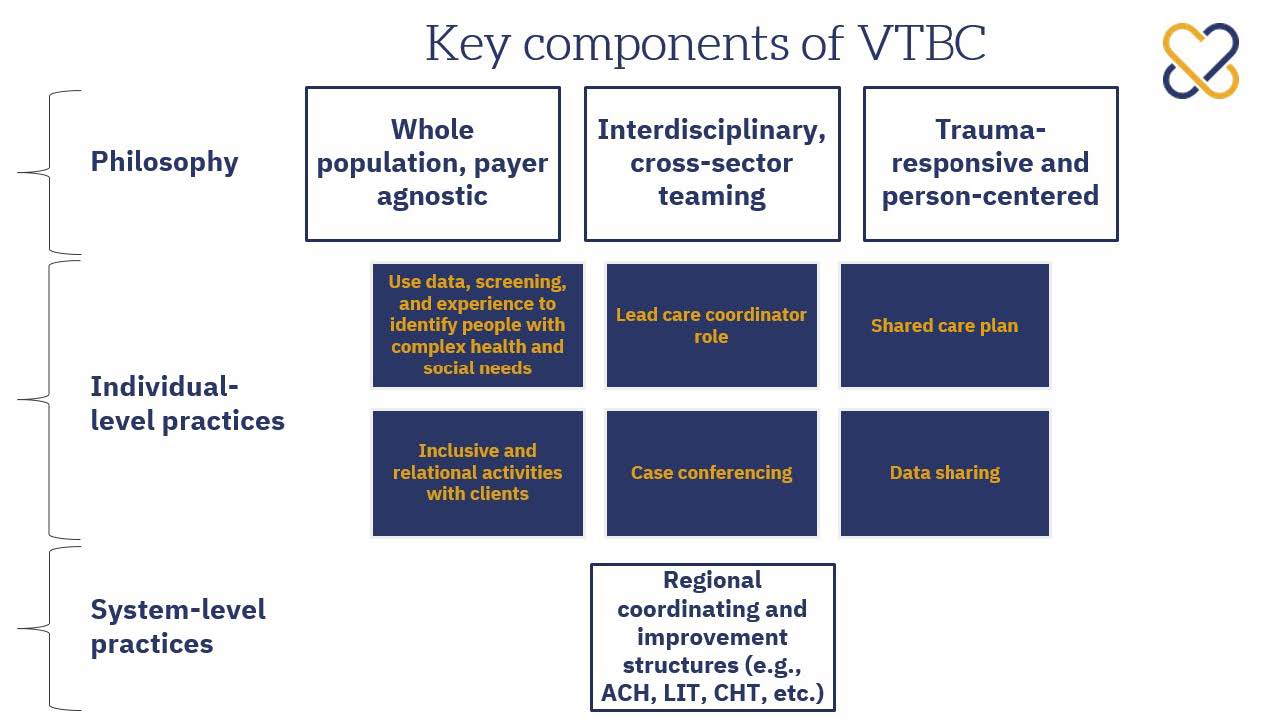VTBC: Vermont Team-Based Care
What is VTBC?
Vermont Team-Based Care (VTBC) is a philosophy and set of individual and system-level practices to support people who have chronic health, mental health, substance use and/or social needs. At its foundation, healthcare and human services organizations work together in partnership with the individual or family to identify needs, access appropriate resources and services, and support progress towards individual goals. VTBC is not a new model– it was initially launched in 2015 as Complex Care and has been happening in communities across Vermont for years. Last year, we worked with the Camden Coalition to, with the help and feedback of many stakeholders, assess where we are in the adaptation and spread of this work. This year, we have the chance to expand and strengthen Complex Care, now called VTBC, through learning collaboratives and training opportunities.
The VTBC philosophy describes the way healthcare and human services are delivered for all Vermonters. It is trauma-responsive and person-centered and requires teams to work across disciplines and sectors to support people in their medical, mental health, substance use, and social needs. At every entry point into the system of care, agency staff and providers screen for needs so that people can be connected to support if they wish. The goal is to be more proactive in care, help people reach their goals, and rebuild trust in the community.
The VTBC individual practices include assessing biopsychosocial needs, helping identify goals, connecting to services and benefits, and supporting behavior change to reach those goals. The intensity of care coordination in VTBC varies based on how much help someone needs and how complex their situation is. VTBC also includes collaborative practices among providers (lead care coordinator, shared care plan, case conferencing) to ensure that they are working as a team to achieve shared goals defined by the individual.
The VTBC systems practices connect AHS and a vast array of organizations across the regional health and human services ecosystem.

Who is eligible for VTBC?
Team-based care serves a wide range of Vermonters who experience complex health and/or social needs. It's especially useful for those who need ongoing help from multiple providers or organizations. Each community decides who's eligible based on data, experience, and expert opinion.
How does VTBC fit into national trends?
VTBC is part of a national movement called complex care, which seeks to improve health and well-being for people with complex health and social needs by coordinating and reshaping care delivery at the individual, community, and system levels. Complex care addresses root causes of poor health through interdisciplinary care teams and cross-sector partnerships that deliver person-centered care based around participants’ own goals and priorities.1 There is an increasing acknowledgement around the country of the importance of addressing social drivers of health for overall well-being.2
In Massachusetts, it was shown that integrated and cross-organizational care teams are essential for high-quality care for people with complex health and social needs and that successful integrated care planning places the individual at the center of care by building relationships, establishing clear communication, and clarifying shared care planning processes.3
What’s next for VTBC?
Providers across Vermont are already doing VTBC. Over the next year, with support from the Camden Coalition, we will systematically document best practices in VTBC while also developing online, self-paced training and education materials to ensure that all staff now and in the future are appropriately trained and supported on the core elements and practices of VTBC. Your feedback on what's working and what's not will be crucial in making VTBC better statewide. Our goal is to make sure people with complex health and social needs have a better experience and that you feel supported in treating them as a whole person.
In an effort to strengthen and continuously advance VTBC, we are launching a statewide learning collaborative. The community in each health service area will identify 1-2 priority areas for improvement and designate change teams to work on small tests of change to address those focus areas. The change teams will receive support from the Blueprint team, Field Director, and an expert facilitator from the Camden Coalition. At several points throughout the learning collaborative, change teams will come together with one another to share their progress and learning.
______________________________________________________________________________________________________________________________________________________
1 Camden Coalition. What is complex care. https://camdenhealth.org/about-us/what-is-complex-care/ 2 National Academies. (2019). Integrating Social Care into the Delivery of Health Care. https://nap.nationalacademies.org/catalog/25467/integrating-social-care-into-the-delivery-of-health-care-moving 3 Center for Health Care Strategies. (2022). Integrated Care Planning for Medicaid Members with Complex Needs. https://www.chcs.org/media/Integrated-Care-Planning-for-Medicaid-Members-with-Complex-Needs_051222.pdf At the end of the year, each community will share what they've achieved so we can learn from each other and develop next steps and recommendations for the Agency of Human Services. We want everyone involved in VTBC to share the same goals and values and to have clear ways of working together to improve care for both providers and patients. By working together, we can make sure Vermonters have better health outcomes. We're committed to keep improving VTBC to make it more engaging, client-centered, holistic, integrated, fair, responsive to trauma, and sustainable.
